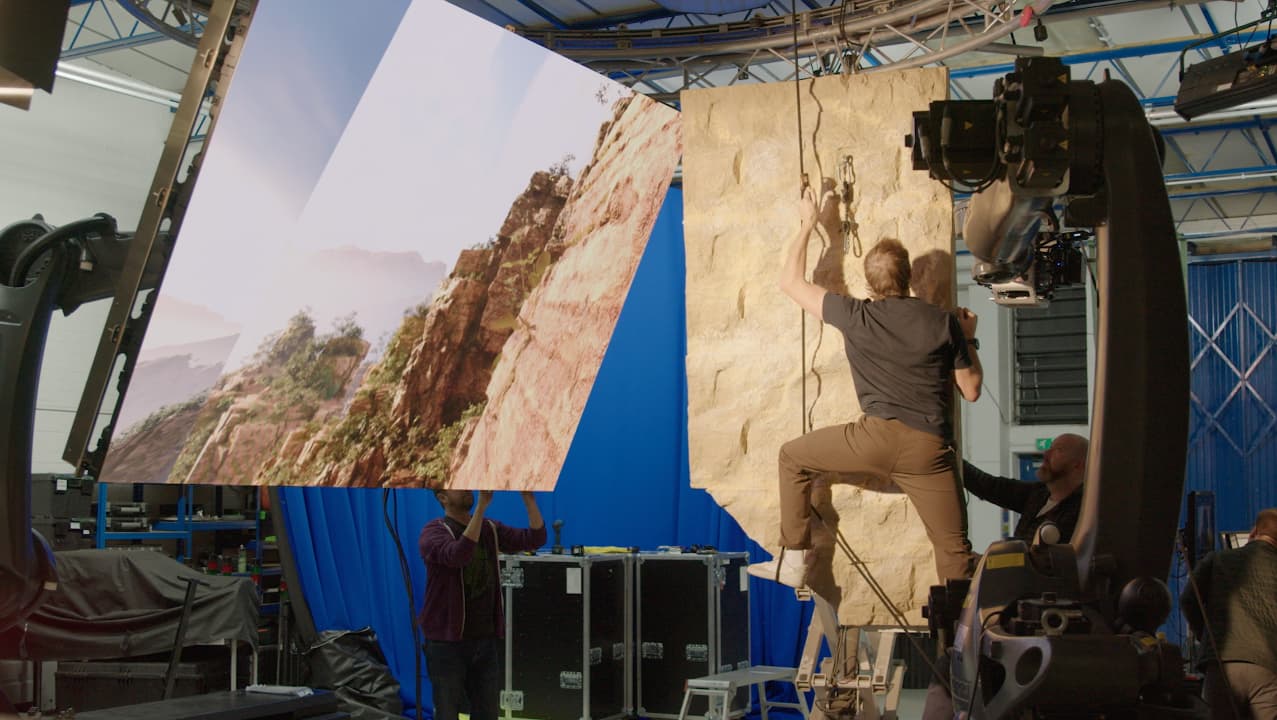
Dimension's ViV (Vectored Imaging Volume) has been created with the goal of allowing existing LED volume shoots to achieve ‘impossible’ shots, as well as bringing the benefits of virtual production to more people in an accessible way.
Developed in-house at Dimension, ViV has been developed in partnership with well-known industry robotics expert Dickon Mitchell. It features two robotic arms; one mounted with a camera, the other with a moveable LED wall. This starts at 2m x 3m, but also has the option to go larger. Together, the two motion controlled components form a dynamic, LED volume, moving in precise synchronisation together with the virtual environment, in real-time.
This setup allows filmmakers to shoot with a much greater range of camera motion as well as movement from performers when shooting against an LED volume as you can see from the video below
“Filmmakers using a large, static LED volume gain so many benefits from their virtual production setup. But even so, there are often several shots that aren’t possible because of the camera movement needed to achieve them,” says Callum Macmillan, Dimension Co-Founder and CTO. “With ViV, filmmakers continue to take advantage of VP’s benefits, while also being able to achieve those impossible shots.”
There are some definite shots that are harder to pull off in LED volumes than others. Those which are hard to achieve in fixed large-volume LED stages include anything with a large range of movement from an actor, such as walking through multiple locations or through doors and around corners. Shots that require a camera to look up or down, which would usually be limited by a volume being a wall and not extending onto a floor or ceiling, are equally hard to pull off.
The idea is that by adding motion to the LED volume itself, all of those movements are now possible.
The team behind ViV has produced two demo pieces, The Climb and The Office, that showcase the functionality of ViV with support from LED partner ROE.
Dimension says that ViV can be rolled out as a complementary set up to an existing large volume VP shoot and as a standalone system. The cost and resources needed to run ViV makes it an accessible option for filmmakers who donate have the budget for a large VP volume.
“You can see in the amount, and different types, of productions that are shooting with volumes that virtual and LED production isn’t simply a fad. And it will obviously continue to evolve,” says Macmillan. “We see ViV not only as an extension of what Dimension can offer in virtual production but as the next step in its evolution. What ViV unlocks isn’t available anywhere else, we can scale it to incorporate other robotic systems for elements such as human-flying rigs, vehicle platforms, additional camera, lighting and panel systems. This is just the start of motion controlled VP.”
tl;dr
- Dimension's ViV (Vectored Imaging Volume) allows filmmakers to achieve 'impossible' shots with LED volume shoots, enhancing accessibility to virtual production.
- Developed in collaboration with robotics expert Dickon Mitchell, ViV consists of two robotic arms: one with a camera and the other with a moveable LED wall, starting at 2m x 3m with options for larger setups.
- This setup enables greater camera motion and performer movement, overcoming limitations of static LED volumes, particularly for shots requiring extensive range or specific angles.
- ViV can be implemented alongside existing large volume setups or as a standalone system, providing an affordable option for filmmakers interested in virtual production without the need for a large budget.
Tags: Virtual Production Dimension


Comments